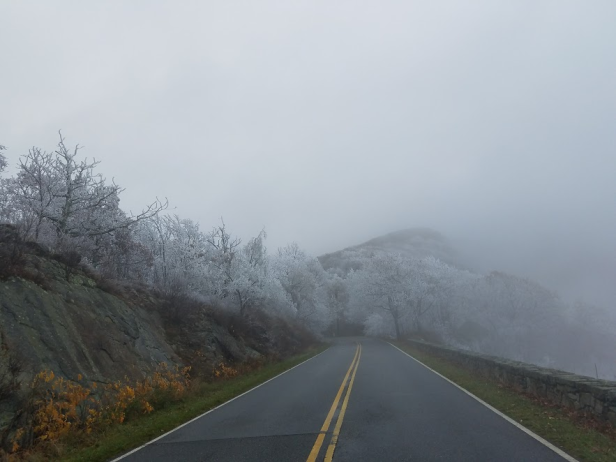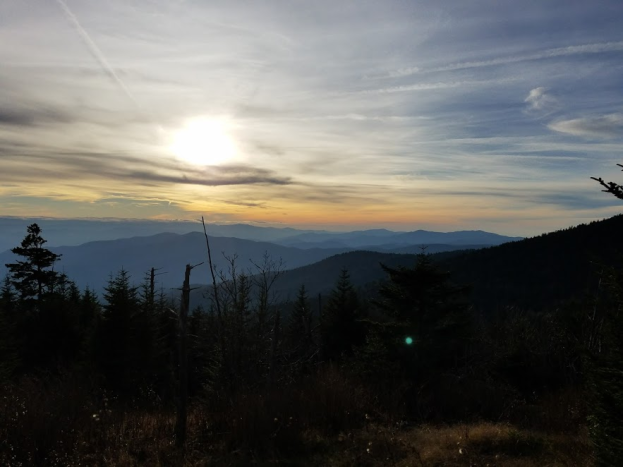To continue my national park exploration, I traveled to the western side of Virginia to check out Shenandoah, a place I’ve wanted to visit ever since I sang “Oh, Shenandoah” on repeat as a child.
My mom instilled a love of old folk songs when I was younger, and this song is one of my favorites. I still find myself singing “Shenandoah” as my mind wanders while hiking and am transported to the Appalachia of my imagination. Now I was ready to see how my idea of the area compared to its reality.
I imagined rolling mountains with idyllic valleys and blue horizons, practically the exact view I was awarded when entering Skyland Drive from the north end of the park. Skyland Drive traverses 105 miles along the crests of the hills running north to south in Shenandoah National Park. Finished in 1939, Skyline Drive was one of many projects funded by New Deal legislation and built by the Civilian Conservation Corps (CCC). The drive has 75 overlooks where amazing views are afforded when trees part and the countryside spans out on either side of the highway.
Skyland Drive traverses 105 miles along the crests of the hills running north to south in Shenandoah National Park. Finished in 1939, Skyline Drive was one of many projects funded by New Deal legislation and built by the Civilian Conservation Corps (CCC). The drive has 75 overlooks where amazing views are afforded when trees part and the countryside spans out on either side of the highway.

As I drove into the park from the north, a storm was building and following me down the range, creating menacing clouds that fractured the sunlight. Fall colors were valiantly making their last show, and when the sun broke through the clouds it illuminated the fiery yellows and oranges burning along the hillsides. The Shenandoah Valley runs between two of the many ranges that make up the Blue Ridge Mountains, an aptly named range since the ridges really are blue as they cascade into the distance. I wasn’t sure if the impending storm created the blue haze the first day I was there, but I soon learned that the haze remains regardless of the weather.
The Shenandoah Valley runs between two of the many ranges that make up the Blue Ridge Mountains, an aptly named range since the ridges really are blue as they cascade into the distance. I wasn’t sure if the impending storm created the blue haze the first day I was there, but I soon learned that the haze remains regardless of the weather.
After some cursory research, I learned a combination of hydrocarbons released from vegetation on the hills and light refraction are most responsible for the blue haze. The trees, especially conifers, release hydrocarbons such as terpenes that react with natural ozone molecules which then creates a hazy effect. Light is scattered by the ozone as it enters the atmosphere, and our eyes pick up on the blue wavelengths most readily, resulting in a sky and horizon that look blue. The dense vegetation of the Blue Ridge Mountains simply concentrates and magnifies the haze that our eyes then interpret as blue.
The area has long been known for its blue haze. The Cherokee called the area “Shaconage”, or land of blue smoke, a concept European explorers cemented when they named both the Blue Ridge and the Great Smoky Mountains.

- The depth of the range is obscured by both the haze and the impending rain.
Shenandoah is also known for its many waterfalls, which we wanted to explore as well. Since Skyline Drive winds along the top of the mountains, most hikes all start downhill and end with a climb. We took off towards White Birch Falls and were not disappointed. If it had been 90 rather than 45 degrees, I would’ve jumped in in a heartbeat! As we headed out of the park for the evening, we met an amazing sunset with warm alpine light that contradicted the devilishly cold night we would have. I woke up to 26 degrees the next morning, a cold only concentrated by the humidity brought with the rain.
As we headed out of the park for the evening, we met an amazing sunset with warm alpine light that contradicted the devilishly cold night we would have. I woke up to 26 degrees the next morning, a cold only concentrated by the humidity brought with the rain. We traveled back to finish the southern half of Skyline Drive, and as we climbed towards the mountaintops, dense fog rolled in and almost obscured the road in many places. The higher we drove, the colder the air became and the fog froze on the trees.
We traveled back to finish the southern half of Skyline Drive, and as we climbed towards the mountaintops, dense fog rolled in and almost obscured the road in many places. The higher we drove, the colder the air became and the fog froze on the trees.

While at first I wasn’t too keen on the cold since I wanted to hike some more, I concluded it allowed me a vision into the winter scene of the area after soaking up a fall day before. We finished the 105-mile drive and headed southwest for the Great Smoky Mountains, a range also known for its waterfalls and blue ridges.
We hit the trails right off the bat for a nice 4-mile jaunt along the Oconaluftee River. Instantly, I recognized a different quality to the water in the Smokies. I can’t really describe it other than more clear, white, and smooth. I’ve never seen creeks like the ones running all over the park and continuously stopped to soak up the views. Green moss and dense rhododendrons blanketed the rocks and banks as the water rushed by. If there ever was a place for fairies, this was it. We later learned that dogs are not allowed on the trails anywhere in the park, a rule rangers usually enforce very strongly. Luckily, our illicit hike went unnoticed and we emerged from the park unscathed. We didn’t do any more hiking, which I found unfortunate, but the weather also turned, so perhaps it was all for the best.
We later learned that dogs are not allowed on the trails anywhere in the park, a rule rangers usually enforce very strongly. Luckily, our illicit hike went unnoticed and we emerged from the park unscathed. We didn’t do any more hiking, which I found unfortunate, but the weather also turned, so perhaps it was all for the best.

- Evidence of our criminal activity. Parks that don’t allow dogs don’t score well with me. Sorry Smokies, you lost major points!
We caught the sunset on top of Clingman’s Dome, the highest point in the Smokies at 6,644 ft. A road leads to the top, and a short half mile hike ascends to an observation tower. The air was chilling quickly as I made my way to the observation tower and soaked up the view from the top. As usual, the pictures didn’t do the view justice, but I still took them as a rudimentary way to capture the essence of the moment.
As usual, the pictures didn’t do the view justice, but I still took them as a rudimentary way to capture the essence of the moment.
My road keeps leading forward, and with a month left of my journey, I am already feeling the pangs of sadness and happiness I know I will feel when I make my way back home. I’ve already seen so much country, but it’s only opened my eyes to how much more there is to see. While I could do with some warmer weather and more daylight, I am far from ready for the sun to set on this trip and already feel myself planning the next.

- Looking down the walkway at Clingman’s Dome.
SO. BEAUTIFUL.
Do you know the history of the song “Shenandoah”? Any chance it’s Civil-War related?
I suppose I could do my own googling since you’re busy adventuring and what not… 🙂
LikeLike
According to the Library of Congress, it most likely originated in the fur trapping world in the early 1800s. Most believe it to be a song sung to an Iroquois chief named Shenandoah by a white fur trapper who wished to marry his daughter. Alternatively, it is thought to be a sea shanty sang by traders up and down the Missouri, but in either case, Confederate soldiers made it even more prominent during the Civil War.
Thanks for the question since I had assumed it simply originated during the war and hadn’t actually looked at the lyrics closely enough!
LikeLike